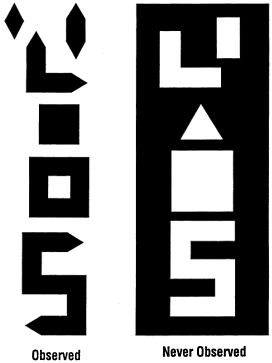
When scientists study any system they must ask two basic questions:
1) What are the basic objects, or "building blocks," from which this system is made?
2) What are the interactions between these objects?
The answer to these questions depends on the scale at which you study the system. Particle physics plays this game on the smallest possible scales -- seeking to discover the basic building blocks of all matter and the fundamental interactions between them.
The connecting rules of these interactions, or basic forces, explain why some composite objects are observed and others are not observed. The basic forces are as important as the "building blocks" in explaining data, and what does not happen is as important a clue as what does.
This puzzle shows the challenge that particle physicists face. Imagine that the puzzle presents information that was obtained about particles from an accelerator. The black figures represent objects that were observed, while the objects shown in white have not been observed. In this puzzle, "objects" are all two-dimensional shapes, and "interactions" are ways in which they can combine.
The shapes that are not observed provide important clues to the answers.

Write your answers in these spaces. Note that you need to answer both questions to explain why the objects that are not observed are not possible.
The observed figures are constructed from:
1. ______________________________________
______________________________________
2. ______________________________________
______________________________________
The rules for connecting these shapes are:
1. ______________________________________
______________________________________
2. ______________________________________
______________________________________
[Puzzle adapted from Helen Quinn, "Of Quarks, Antiquarks, and Glue." The Stanford Magazine, Fall, 1983, p.29.]